Exploring the Future of Cannabis Breeding: Trends and Innovations

Welcome to our in-depth exploration of the future of cannabis breeding! As the industry continues to grow and evolve, staying on top of the latest trends and innovations is crucial for breeders, consumers, and the industry as a whole.
In this article, we will delve into the current state of cannabis breeding, its historical context, and the latest trends and innovations. We will also discuss the challenges and opportunities that lie ahead and the importance of sustainable and eco-friendly approaches.
Key Takeaways:
- Staying informed about the latest trends and innovations in cannabis breeding is crucial for breeders and consumers
- Cannabis breeding has a rich history and has evolved over time
- The latest trends include focusing on unique and exotic varieties and genetic traits
- Innovations in breeding techniques include the use of genetic markers, tissue culture, and cutting-edge technologies
- Sustainable and eco-friendly approaches are becoming increasingly important
- The future of cannabis breeding holds both challenges and opportunities
Understanding Cannabis Breeding and Its Evolution
Cannabis breeding is the practice of selecting and crossing different strains in order to develop new and improved varieties with specific traits. This process has been going on for thousands of years, but it wasn’t until the 20th century that cannabis breeding really took off.
In the early days of cannabis breeding, the focus was on developing strains with high THC content. This was driven by the demand for recreational use and the psychoactive effects of THC. However, as the cannabis industry has evolved, the goals of breeding have also shifted.
Today, breeders are focused on developing strains that not only offer high THC content, but also desirable terpene profiles and specific medicinal properties. This shift in focus has been driven by the growing demand for specialized strains for both recreational and medicinal purposes.
| Goal of Breeding | Description |
|---|---|
| Improved yield | Breeders aim to produce strains with higher yields in order to increase profitability for cultivators. |
| Potency | High levels of THC and other cannabinoids are desirable for recreational use and for treating certain conditions. |
| Flavor profiles | Cannabis connoisseurs place a high premium on strains with unique and desirable flavor profiles. |
| Medicinal properties | With the growing acceptance of cannabis for medicinal use, breeders are developing strains with specific medicinal properties to treat a range of conditions. |
The evolution of cannabis breeding has also been shaped by advances in technology. In recent years, the use of genetic markers and other advanced techniques has allowed breeders to develop new strains more quickly and accurately than ever before. This has helped to speed up the breeding process and create more targeted and specialized strains.

Looking ahead, the future of cannabis breeding is likely to be shaped by a variety of factors, including changing regulations, advancements in technology, and shifting market demands. However, one thing is certain: cannabis breeding will continue to evolve in order to meet the needs of cultivators, consumers, and patients.
The Latest Trends in Cannabis Breeding
In recent years, the cannabis industry has experienced tremendous growth, resulting in increased demand for unique and exotic strains. Breeders have responded to this demand by focusing on developing strains with specific genetic traits, resulting in an explosion of new varieties.
One major trend that has emerged is the popularity of high-THC strains. Consumers are seeking out strains with high levels of THC, the psychoactive compound in cannabis. Breeders are responding to this trend by developing strains with higher and higher THC concentrations, often exceeding 30 percent.
Another trend in cannabis breeding is the focus on terpene profiles. Terpenes are aromatic compounds found in cannabis that contribute to its flavor and aroma. Breeders are developing strains with unique and complex terpene profiles, resulting in a wide range of flavors and aromas.
| Popular Strains | Genetic Traits |
|---|---|
| OG Kush | High THC |
| Gelato 33 | Unique Terpene Profile |
| Blue Dream | High Yield |
The demand for CBD-rich strains has also increased in recent years. CBD, or cannabidiol, is a non-psychoactive compound found in cannabis that has been shown to have potential health benefits. Breeders have been developing strains with high CBD concentrations, often exceeding 20 percent.
Finally, breeders are focusing on developing strains with unique and exotic genetics. This trend has resulted in the development of strains with colorful flowers, unique growth patterns, and unusual aromas.
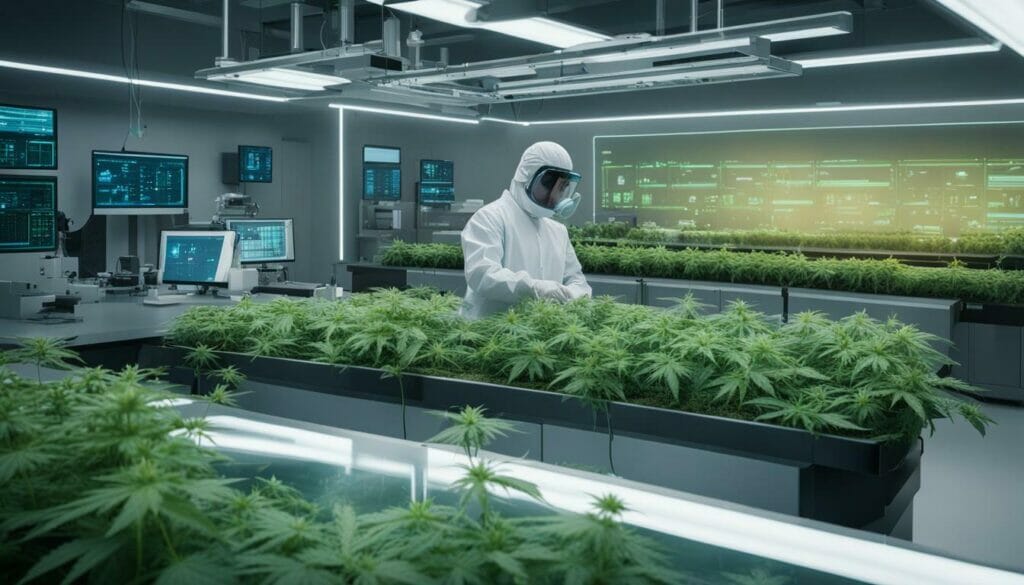
Innovations in Cannabis Breeding Techniques
Cannabis breeding is constantly evolving, and breeders are utilizing cutting-edge techniques to develop new and unique strains. Let’s explore some of the most exciting innovations in cannabis breeding techniques.
One advancement is the use of genetic markers. By identifying specific genes associated with desired traits, breeders can make more informed decisions about which plants to breed. This results in more efficient and targeted breeding, saving time and resources in the process.
Another technique that is gaining popularity is tissue culture. This involves growing cells or tissues in a controlled environment, which allows breeders to create identical clones of desired plant varieties. Tissue culture is particularly useful for maintaining genetic purity and consistency in strains.
Breeders are also using other cutting-edge technologies such as CRISPR to edit the genome of cannabis plants. This has the potential to create custom cannabinoid profiles, which could result in the development of new strains with unique therapeutic properties.
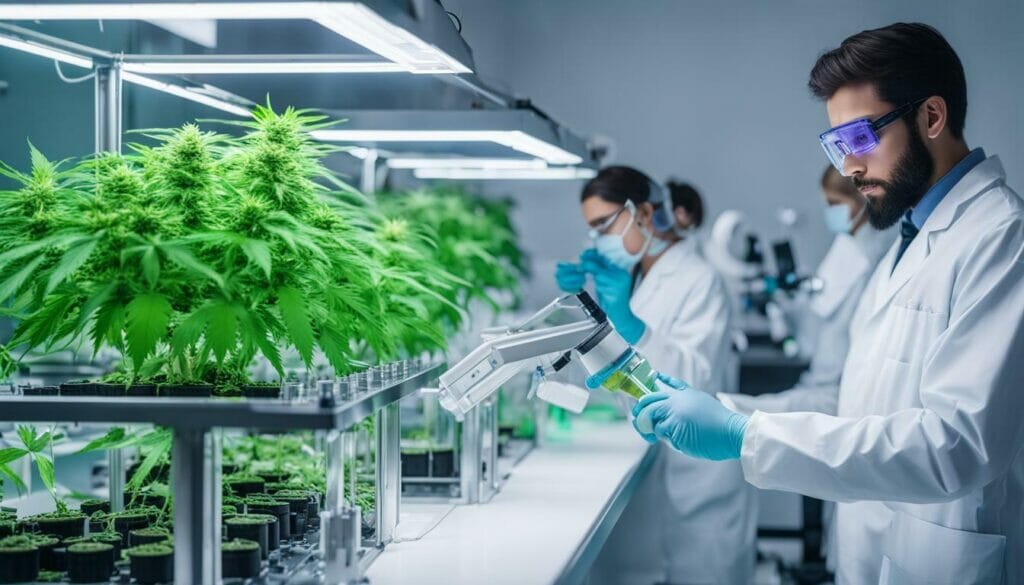
As technology continues to advance, it is likely that more innovative techniques will emerge. These advancements will not only benefit breeders, but also consumers who will have access to new and exciting strains.
Sustainable and Eco-friendly Approaches in Cannabis Breeding
As the demand for legal cannabis grows, so does the need for sustainable and eco-friendly approaches to production. Cannabis breeding is no exception, with breeders exploring ways to develop cultivars that require fewer resources to thrive.
One approach is the use of organic methods, which eliminates the need for synthetic fertilizers and pesticides, reducing the environmental impact of cultivation. In addition, selective breeding can lead to plants that require less water, helping to conserve this precious resource in areas that are prone to drought.
Another promising area of development is the use of tissue culture, which allows for the propagation of new plants from a small number of parent plants. This not only reduces the need for large-scale cultivation but also ensures genetic uniformity and disease resistance.
The Benefits of Eco-friendly Breeding
The benefits of adopting sustainable and eco-friendly approaches to cannabis breeding are numerous. For one, it helps to minimize the environmental impact of cultivation, allowing growers to operate in a more responsible and ethical manner. Additionally, it can help to reduce costs associated with resource-intensive cultivation practices, such as excessive water usage or synthetic fertilizers.
Furthermore, consumers are increasingly demanding eco-friendly products, and cannabis is no exception. By developing sustainable and eco-friendly cultivars, breeders can tap into this growing market demand and position themselves as leaders in the industry.
| Did you know? | The use of synthetic fertilizers and pesticides can have a devastating impact on ecosystems, including soil degradation, water pollution, and harm to beneficial insects and animals. |
|---|
The Future of Sustainable Cannabis Breeding
Looking ahead, breeders are exploring innovative ways to develop more sustainable and eco-friendly cannabis strains. For example, some are experimenting with intercropping, which involves growing multiple crops together in the same field, allowing for a more efficient use of resources such as water and nutrients.
Another area of development is the creation of cultivars that are specifically bred for their resiliency to climate change. With more extreme weather patterns expected in the coming years, breeders are working to develop plants that can withstand drought, floods, and other environmental stressors.
By embracing sustainable and eco-friendly approaches, cannabis breeders can not only help to preserve the environment but also position themselves for success in an increasingly competitive market.

Emerging Innovations in Cannabis Breeding
As the cannabis industry continues to grow, so does the need for new and innovative breeding techniques. From genetic editing to CRISPR technology, breeders are exploring new ways to develop unique and potent strains to meet the demands of consumers.
One emerging technology that has the potential to revolutionize cannabis breeding is genome editing. With genome editing, breeders can create precise changes to the DNA of the plant, resulting in new and highly desirable traits. For example, breeders could use genome editing to increase the amount of THC or CBD in a strain, or to create custom cannabinoid profiles tailored to specific medical conditions.
Another promising innovation is CRISPR technology. CRISPR allows breeders to make precise cuts to the DNA of the plant, enabling the removal or addition of specific genes. This technology could be used to eliminate unwanted traits, such as the tendency for plants to hermaphrodite, or to introduce desirable traits, such as disease resistance or increased yield.
In addition to these cutting-edge technologies, breeders are also exploring new ways to incorporate sustainability and eco-friendliness into their breeding practices. For example, some breeders are developing cultivars that require less water or fertilizer to thrive, reducing the strain on natural resources.
| Innovation | Description |
|---|---|
| Genome Editing | Precise changes to DNA to create unique and highly desirable traits. |
| CRISPR Technology | Precise cuts to the DNA of the plant, enabling the removal or addition of specific genes. |
| Sustainability | Developing cultivars that require less water or fertilizer to reduce the strain on natural resources. |
The future of cannabis breeding is exciting and full of potential. With the development of new technologies and sustainable practices, breeders are poised to meet the demands of consumers while reducing their impact on the environment.
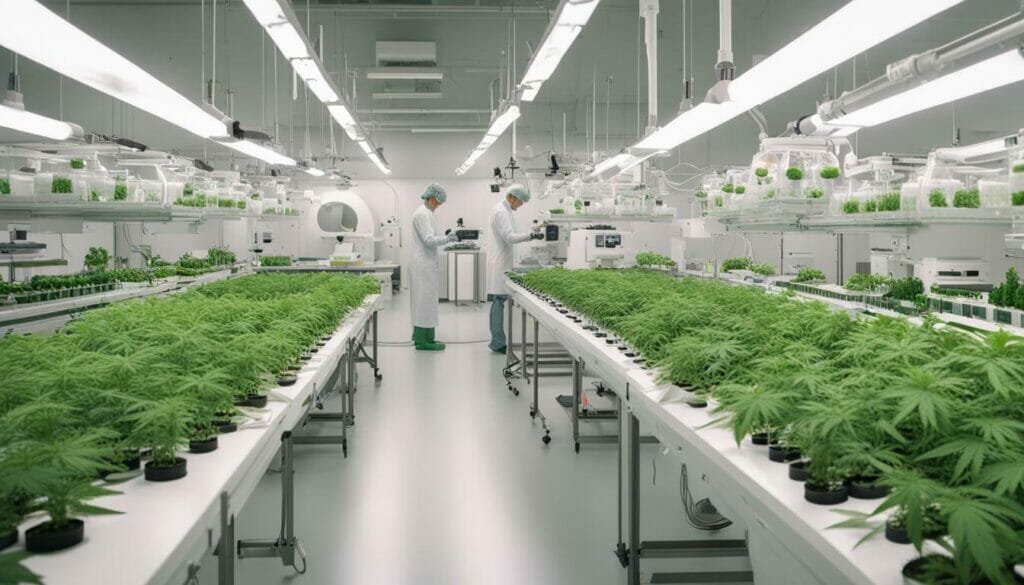
The Role of Data and Analytics in Cannabis Breeding
In today’s age, data analytics plays a crucial role in the success of any business or industry, and cannabis breeding is no exception. The use of data and analytics in cannabis breeding is becoming increasingly prevalent as breeders seek to create new varieties with desirable traits that meet the demands of the market.
One of the main advantages of using data in cannabis breeding is the ability to make informed decisions. By analyzing data on the performance of different strains, breeders can identify traits that are most valuable to consumers and determine which strains are worth investing time and resources into breeding.
| Benefits of data analytics in cannabis breeding | Examples |
|---|---|
| Identifying desirable traits | Analyzing data on cannabinoid and terpene profiles to determine which strains are most popular among consumers. |
| Improving strain stability | Using data to track the performance of different strains over time and identify which ones are the most stable, thus reducing the risk of genetic drift. |
| Enhancing breeding efficiency | Using data to identify which strains are most closely related genetically, which can help to reduce the time and resources needed to create new varieties. |
Another benefit of using data analytics in cannabis breeding is the ability to improve strain stability. By tracking the performance of different strains over time, breeders can identify which ones are the most stable and thus reduce the risk of genetic drift, which can lead to variations in traits and reduced potency.
Finally, data analytics can also help to enhance breeding efficiency. By using data to identify which strains are most closely related genetically, breeders can reduce the time and resources needed to create new varieties, which can be a significant cost savings.
Overall, the use of data and analytics is becoming increasingly important in the field of cannabis breeding. As the industry continues to evolve and new strains are developed, we can expect data analytics to play an even bigger role in helping breeders create the next generation of cannabis plants.

Regulations and Legal Considerations in Cannabis Breeding
As with any industry, cannabis breeding is subject to a range of regulations and legal considerations. Breeders must be aware of the laws governing their work, including licensing requirements, intellectual property protection, and compliance with local and federal regulations. Failure to comply with these laws can result in fines, legal action, and damage to the breeder’s reputation.
Licensing Requirements
Cannabis breeding is a heavily regulated industry, and breeders must obtain the appropriate licenses from their local and federal governments. These licenses typically require the breeder to undergo a background check and meet certain qualifications, such as having a clean criminal record or a degree in horticulture. Breeders must also adhere to strict guidelines regarding the storage, handling, and transportation of cannabis plants and seeds.
Intellectual Property Protection
Intellectual property protection is a crucial consideration for cannabis breeders, as it allows them to protect their unique strains and prevent others from profiting from their work. However, cannabis remains illegal at the federal level in the United States, making it difficult for breeders to obtain patents or other forms of protection. Breeders must therefore rely on trade secrets and contracts to safeguard their intellectual property.
Compliance with Local and Federal Laws
Breeders must also comply with local and federal laws regarding the cultivation and sale of cannabis. This includes restrictions on the quantity of plants that can be grown, the potency of the resulting strains, and the labeling and packaging of cannabis products. Breeders must also stay up-to-date with changes in the regulatory environment, as laws regarding cannabis are often subject to rapid change.

While navigating the legal landscape of cannabis breeding can be challenging, it is essential for breeders to stay compliant with the laws and regulations that govern their work. Failure to do so can result in serious consequences, both for the breeder and for the wider cannabis industry. By staying informed and up-to-date on regulatory changes, breeders can position themselves for success while also contributing to the continued growth and development of the cannabis industry.
Challenges and Opportunities in the Future of Cannabis Breeding
Cannabis breeding is a rapidly evolving field with exciting new developments emerging every day. However, as with any industry, there are challenges that need to be addressed to ensure its continued growth and success.
One of the biggest challenges facing cannabis breeders is the lack of standardization in the industry. With no uniform regulations or guidelines, it’s difficult to ensure consistency in breeding practices and strains. This can lead to confusion among consumers and create barriers to entry for new breeders.
Another challenge is the legal landscape surrounding cannabis breeding. While many states have legalized cannabis, it remains illegal at the federal level, posing a risk for breeders who may face legal repercussions for their work. It’s crucial for breeders to stay informed about local and federal laws and be proactive in complying with them.
Furthermore, as the cannabis industry continues to grow, it’s important for breeders to consider the environmental impact of their practices. The cultivation of cannabis can be resource-intensive, and breeders should look for ways to reduce their carbon footprint and promote sustainability.
Despite these challenges, there are also numerous opportunities for growth and innovation in cannabis breeding. The increasing demand for high-quality strains and unique flavor profiles creates opportunities for breeders to differentiate their products and stand out in a crowded market.
Additionally, advancements in technology and data analytics provide breeders with powerful tools to develop new strains and improve existing ones. This can lead to the creation of custom cannabinoid profiles tailored to specific medical conditions or consumer preferences.
Finally, collaboration among breeders and researchers can drive innovation and help overcome the challenges facing the industry. By sharing knowledge and resources, breeders can work together to develop better breeding practices and create new and exciting strains.

Overall, the future of cannabis breeding is bright, with many opportunities for growth and innovation. However, breeders must also be aware of the challenges facing the industry and be proactive in addressing them. By working together and staying informed about the latest trends and innovations, the cannabis breeding industry can continue to thrive and bring exciting new products to consumers.
Conclusion
Cannabis breeding is a constantly evolving field that requires staying up-to-date with the latest trends and innovations. Breeders must strive to develop strains that meet the demands of the market while also considering sustainable and eco-friendly approaches. The use of cutting-edge techniques and tools, such as genetic markers, data analytics, and CRISPR technology, is revolutionizing the way breeders develop new strains.
The Future of Cannabis Breeding
The future of cannabis breeding is full of challenges and opportunities. With potential regulatory changes and market demands, breeders must work together with researchers to create new and exciting strains that meet the needs of consumers. Collaboration and communication will be key to unlocking the full potential of cannabis breeding.
As cannabis legalization continues to spread, the industry is expected to grow exponentially, and breeders will play an essential role in shaping this growth. It is vital to keep in mind the legal and regulatory considerations that come with cannabis breeding, such as licensing requirements and intellectual property protection.
Overall, the future of cannabis breeding is bright, and there are many exciting opportunities ahead. By staying informed, using cutting-edge techniques, and working together, breeders can continue to push the boundaries of what is possible in the world of cannabis breeding.
FAQ
Q: What is cannabis breeding?
A: Cannabis breeding is the process of selectively cross-breeding different strains of cannabis plants to create new varieties with desired traits.
Q: Why is staying up-to-date with cannabis breeding trends and innovations important?
A: Staying up-to-date with cannabis breeding trends and innovations is important because it allows breeders to create new and improved strains that meet the demands of consumers and the industry.
Q: What are some current trends in cannabis breeding?
A: Some current trends in cannabis breeding include focusing on popular strains, genetic traits, and the demand for unique and exotic varieties.
Q: What are some cutting-edge techniques used in cannabis breeding?
A: Some cutting-edge techniques used in cannabis breeding include the use of genetic markers, tissue culture, and other advanced technologies that help breeders develop new strains more effectively.
Q: Are there sustainable and eco-friendly approaches to cannabis breeding?
A: Yes, there are sustainable and eco-friendly approaches in cannabis breeding, such as using organic methods and developing cultivars that require fewer resources to grow.
Q: What are some emerging innovations in cannabis breeding?
A: Some emerging innovations in cannabis breeding include genome editing, CRISPR technology, and the potential for creating custom cannabinoid profiles.
Q: How do data and analytics play a role in cannabis breeding?
A: Data and analytics play a crucial role in cannabis breeding by helping breeders make informed decisions, improve strain stability, and enhance desired traits.
Q: What are the legal considerations in cannabis breeding?
A: Legal considerations in cannabis breeding include licensing requirements, intellectual property protection, and compliance with local and federal laws.
Q: What challenges and opportunities lie ahead in the future of cannabis breeding?
A: The future of cannabis breeding faces challenges such as potential regulatory changes and market demands, but also offers opportunities for collaboration and innovation among breeders and researchers.
Suggested Articles
;)
;)
;)



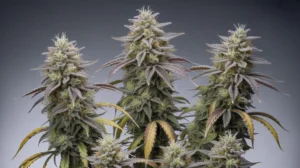
 18 Dec 2025
18 Dec 2025  5 min read
5 min read
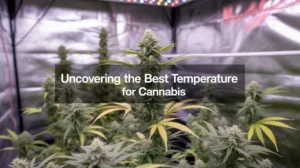

 November 08, 2023
November 08, 2023 


RESPONSES (0)
No responses yet. Be the first to respond!